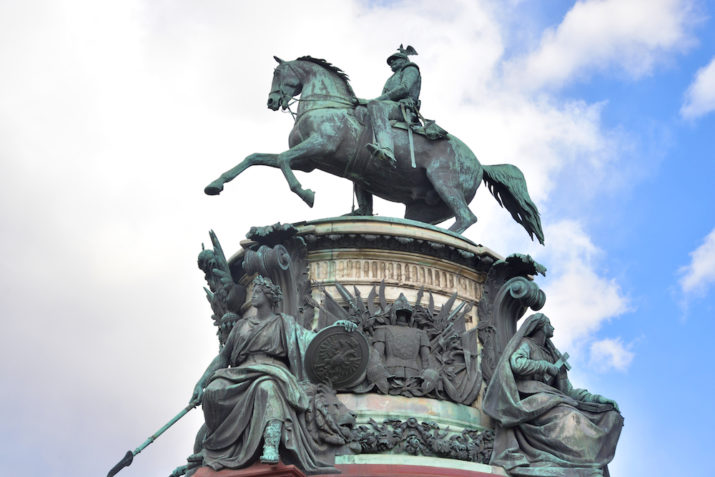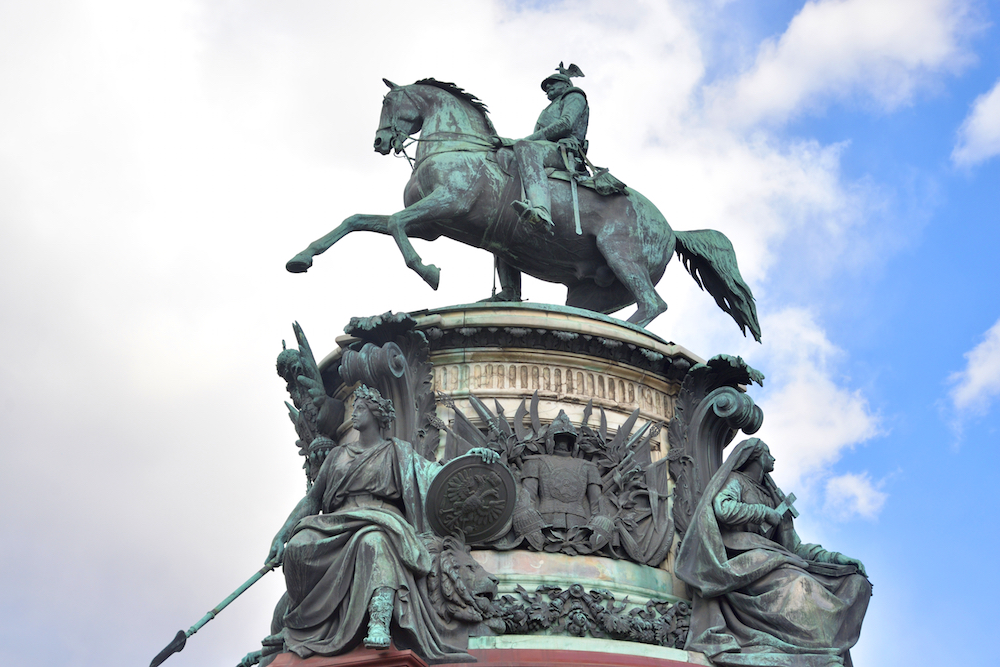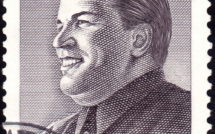
Imagining Russian Regions: Subnational Identity and Civil Society in Nineteenth-Century Russia

Before the fall of the Soviet Union in 1991, not much attention was given to the history of civil society in Russia. Afterwards, however, this question became widely studied. The focus shifted from a debate about whether a civil society existed to a discussion of what kind it was and when it came into existence. An optimistic school argued that voluntary societies flourished after the abolition of serfdom in 1861, and that this was evidence of a well-formed civil society. Pessimists countered that peasants, who formed the majority of the population, were not seen as part of civil society due to legal and social norms.[1] Since civil society is a crucial part of any functioning democracy, this search for origins is important.
Russians knew of the idea of civil society for nearly 150 years before the end of serfdom. In 1703, the first Russian use of the term drew upon Aristotle’s concept of a civil society that was contrasted to an uncivil, or uncivilized society. In the 1760s, Russians who had studied with Adam Smith at the University of Glasgow immediately brought back his four-stage theory of history, which argued that all countries would have to transition from an agricultural, or what we would now call “feudal,” stage to a commercial or civil society. Commercial society meant markets, competition, and the spread of knowledge. Civil society referred to more polished manners and a wider range of personal and professional contacts, including voluntary associations. Empress Catherine the Great (r. 1762-1796) was interested in stimulating a commercial society, and thus was willing to listen to Smithian plans to improve the economy, including of the provinces.
The 1830s were what I call the era of small reforms. The reign of Emperor Nicholas I (1825-1855) has often been portrayed as retrograde, but it should rather be seen as having a reforming period earlier on, followed by a more conservative period after, as was the case with his predecessor, Emperor Alexander I, and his successor, Emperor Alexander II. During the 1830s, Nicholas approved a series of Smithian reforms that sought to stimulate the economy by increasing the center’s knowledge of the provinces. As a result, the state established provincial statistical committees and newspapers to study the wealth of provinces and make it known to the center as well as to the provinces. An unintended consequence of this was the formation of a new provincial identity.
During the 1830s and 1840s, a non-noble group of provincial intellectuals began to emerge whose common task was to study the province in these new institutions. This included priests’ sons and bureaucrats, merchants and townspeople. A law of 1837 aided them by giving the governor more power at the provincial level, and thus decreasing the nobles’ control there. These non-noble groups began to articulate a new provincial identity in place of older municipal identities. The province, they argued, should be studied, not simply in its economic aspects, but as an organic totality, in which history and ethnography were equally important. This point of view drew upon Romantic ideas of the “local” as more authentically Russian.
The nobles, in response, created a noble-only district identity based in the district, a territorial subunit of the province similar in size to an American county. They used agricultural societies, which were voluntary associations, to help spread new crops and tools to assist with the transition to market agriculture. Like the era of small reforms, Adam Smith also influenced the nobles, but rather than an industrial future, they hoped for the improvement of agriculture so that the district, and the nobles in it, would become dynamic and wealthy. The 1837 law had not decreased their power at the district level, and so their focus on it had a political as well as an economic dimension. Nicholas Gogol’s novel Dead Souls can be read as a response to these developments, as the first part portrays the provincial town, site of the emerging non-noble public, as inauthentic and meaningless, and the district, with its network of noble estates, as the true heart of Russia, where economic dynamism and tradition could coexist.
In the 1840s, professors at Moscow University popularized the ideas of G.W.F. Hegel, which deeply influenced the intelligentsia just forming at that time. One of the aspects of Hegel’s thought involved civil society, as he was the one who most influentially separated civil society from the state by positing it as a sphere between the state and the family. According to Hegel, property was the ground of freedom, because it provided an independent means of living from the state. Russian Hegelians began to call for the end of serfdom and the creation of a new group that would unite both former masters and former serfs under the common identity of property owners. This intermingled with abolitionist Smithianism, which drew upon Smith’s statements that free labor was more profitable and productive than slave labor, to convince an important group of nobles that serfdom must go.
These identities and groups remained separate until the state, under the new emperor, Alexander II, decided to begin the process of abolishing serfdom. At first, in 1857, provincialist groups dominated the discussion. Provincialists were grand nobles who believed that each province should legislate how serfdom would end in their province. Many of them were not very enthused about the actual end of serfdom, and hoped that such an approach would make it less harmful to the nobles’ interests. As a result, the provinces of European Russia were asked to form provincial committees that made recommendations to the government on how to proceed with ending serfdom. Within each committee, a battle raged between liberals in favor of ending serfdom and conservatives against the change. Aside from Tver,’ the liberals were in the minority in all committees.
By 1858, however, the government had shifted to a strongly centralizing stance under Nikolai Miliutin of the Ministry of Internal Affairs. After the committees had been created and encouraged to propose legislation for their province, they were then told to confine themselves to purely technical questions and told that any further input was unwanted. This angered many of the conservatives and led to a shift leftward, particularly toward Hegelians, whose conceptual division of state and civil society allowed them to make sense of the hostility on a theoretical level. In the winter of 1859-1860, many provincial noble assemblies discussed the abolition of serfdom and criticized the government’s stance, despite being forbidden to do so.
At the same time, in the Vladimir Noble Assembly, an event took place that shows the limits of civil society. The concept of civil society as developed by both Smith and Hegel did not foreground debate and conflict. Even the liberals who believed in the idea of civil society, thus, did not necessarily welcome opposing views. This is clear from the response to the criticism of the nobles’ treatment of their serfs by N. Ia. Dubenskii, secretary of the Iur’ev Agricultural Society and priest’s son. Dubenskii, despite his connection to the Society, was denounced in the noble assembly for his criticisms of the nobility and was run out of the province. Other motions carried at the assembly criticized the government for ignoring the nobles’ advice.
Hegelians had argued that the peasants needed to be given individual property rights so that the nobles and peasants could join together as property owners. However, the state decided to institute communes instead, and to have separate peasant institutions, such as subdistrict courts. The zemstvo, a body of local government that did much for education and medicine in the provinces after its establishment in 1864, allowed for individual large landowners to elect their representatives directly at the district level, while the representatives of communes chose representatives on behalf of the peasants in their commune. Wealthy peasants could vote in the first curia, or division of electors, if they had enough property, however.
While the peasants were rational actors and were highly active in their institutions, they did not perceive a body politic that included the merchants and nobles. Thus, when the Bolsheviks argued that the body politic should include only peasants, workers, soldiers and Cossacks, it chimed with the peasants’ experience. Even though voluntary associations flourished after 1861 and there were many individual attempts to bridge the gap between educated society and the peasants, the structures of society established by the state kept them separate at an institutional level.
Both state and civil society were influenced by the Romantic ideal of a harmonious society. The state hoped that the peasantry would remain a bulwark of support for the Romanov dynasty and thus made the decisions outlined above. Supporters of civil society wanted to play a substantive role in the life of Russia, but this idea was rejected by the state. These supporters, however, also felt that society should be harmonious, which meant that debate was not always welcome. These strands encouraged a certain maximalist pattern of thought that would surface at other times in Russian history.
After 1991, the rise of regional power was only passing, and the state soon reasserted control. Part of the reason why this was possible was that the regional history institutionalized in provincial museums and in the publication of local lore was deeply shaped by its non-political origins, dating to the 1830s. The study of regional history in Russia, unlike in Catalonia, did not provide depth to a political movement but rather continued its study of the cultural and economic heritage of the province, rather than its political history.
Given the difficult circumstances of civil society in Russia since 1991, it is somewhat heartening to realize that civil society in Russia does have a long history, if not an easy one.
Susan Smith-Peter is an Associate Professor at the College of Staten Island who writes on topics related to civil society and regional identity in pre-revolutionary Russia. She is the author of Imagining Russian Regions: Subnational Identity and Civil Society in Nineteenth-Century Russia.
Photo: Monument to Nicholas I on St. Isaac’s Square in St.Petersburg, Russia.
[1] Ilya Gerasimov, Modernism and Public Reform in Imperial Russia: Rural Professionals and Self-Organization, 1905-1930 (New York: Palgrave Macmillan, 2009).




